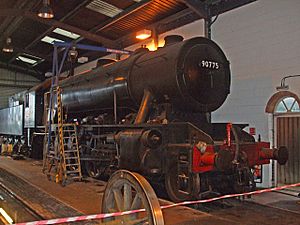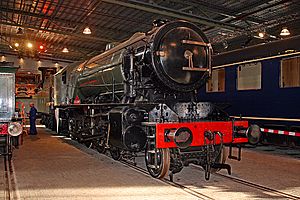WD Austerity 2-10-0 facts for kids
Quick facts for kids WD Austerity 2-10-0 |
|
 |
|
| 90775 on the North Norfolk Railway. Even though it looks like a British Railways train, the highest number for a BR engine was 90774. This one came back from Greece. | |
| Power type | Steam |
|---|---|
| Designer | R. A. Riddles |
| Builder | North British Locomotive Company |
| Serial number | 25436–25535, 25596–25645 |
| Build date | 1943–1945 |
| Total production | 150 |
| Configuration | 2-10-0 |
| UIC classification | 1′E h2 |
| Gauge | 4 ft 8 1⁄2 in (1,435 mm) standard gauge |
| Leading wheel diameter | 2 ft 9 in (838 mm) |
| Driver diameter | 4 ft 8+1⁄2 in (1,435 mm) |
| Length | 67 ft 6+1⁄4 in (20.58 m) over buffers |
| Axle load | 13 long tons 9 cwt (30,100 lb or 13.7 t) |
| Weight on drivers | 67 long tons 3 cwt (150,400 lb or 68.2 t) full |
| Locomotive weight | 78 long tons 6 cwt (175,400 lb or 79.6 t) full |
| Tender weight | 55 long tons 10 cwt (124,300 lb or 56.4 t) full |
| Fuel type | Coal |
| Fuel capacity | 9 long tons 0 cwt (20,200 lb or 9.1 t) |
| Water capacity | 5,000 imp gal (23,000 L; 6,000 US gal) |
| Boiler pressure | 225 lbf/in2 (1.55 MPa) |
| Fire grate area | 40 sq ft (3.7 m2) |
| Heating surface: Tubes | 1,170 sq ft (109 m2) |
| Heating surface: Flues | 589 sq ft (54.7 m2) |
| Heating surface: Firebox | 192 sq ft (17.8 m2) |
| Superheater area | 423 sq ft (39.3 m2) |
| Cylinders | Two, outside |
| Cylinder size | 19 in × 28 in (483 mm × 711 mm) |
| Valve gear | Walschaerts |
| Valve type | 10-inch (250 mm) piston valves |
| Tractive effort | 34,215 lbf (152.20 kN) |
| Power class | BR: 8F |
| Disposition | Eight total preserved or extant (Three in the UK, four in Greece, and one in the Netherlands) remainder scrapped |
The War Department (WD) "Austerity" 2-10-0 is a powerful steam locomotive built during World War II. It was first used in 1943 to help move heavy goods.
Contents
About the Austerity 2-10-0
How it was Designed
This locomotive was based on an earlier design called the WD Austerity 2-8-0. A person named R.A. Riddles designed it so that many of its parts could be swapped with the 2-8-0 model. It had the same power as the 2-8-0 but was lighter on its wheels. This made it good for using on smaller railway lines.
The 2-10-0 had a special design for its boiler and firebox. The firebox, where the coal burns, was wide and placed above the driving wheels. This was a common design in the United States but not so much in Britain at the time. These were the first 2-10-0 locomotives (meaning 2 small wheels at the front, 10 large driving wheels, and 0 small wheels at the back) to work in Great Britain. Later, Riddles used this 2-10-0 wheel setup again for the BR standard class 9F locomotive.
How it was Built
The North British Locomotive Company built 150 of these locomotives. The first 100 were made in 1943 and 1944. Another 50 were built in 1945. They were given WD numbers like 3650–3749 and 73750–73799.
Twenty of the first group were sent to the Middle East. While they were being tested in Britain, their long size made them a bit tricky to use. Most of them ended up helping the British Army in France after D-Day, moving supplies during the push towards the Siegfried Line.
Life After the War
After World War II, the 150 locomotives were sent to different countries. Most of them went to the Netherlands.
| Number of Engines | Country | Company | Class |
|---|---|---|---|
| 103 | Netherlands | Nederlandse Spoorwegen (NS) | NS 5000 class |
| 25 | Great Britain | British Railways (BR) | BR ex-WD Austerity 2-10-0 |
| 16 | Greece | Hellenic State Railways (SEK) | SEK Class Λβ |
| 4 | Syria | Chemins de Fer Syriens (CFS) | CFS Class 150.6 |
| 2 | Great Britain | War Department, Longmoor (WD) | WD Austerity 2-10-0 |
In the Netherlands
In 1946, the Netherlands bought the locomotives that were in Europe. They became known as the NS 5000 class and were numbered 5001-103. They did not work for very long, with the last one being taken out of service in 1952. One of these, number 5085 (which was WD 73755), was special. It was the one-thousandth British-built locomotive sent to Europe after D-Day. It was named Longmoor and is now kept at the Utrecht railway museum.
In British Railways
After the war, British Railways (BR) bought twenty-five of these locomotives. They were first numbered 73774-73798, then later changed to 90750-74. They were mostly used in Scotland by BR to pull heavy freight trains. All of them were taken out of service between 1961 and 1962.
-
BR Scottish Region WD 2-10-0 90768 at Motherwell train shed in 1958
In Greece and Syria
Sixteen of the twenty locomotives that went to the Middle East ended up in Greece. They became the Class Λβ for the Hellenic State Railways, numbered Λβ951 to Λβ966. The remaining four locomotives stayed in Syria and were used by the Chemins de Fer Syriens (CFS). These were known as the CFS Class 150.6.
Still with the War Department
In 1952, the two locomotives that stayed with the War Department (at the Longmoor Military Railway) were renumbered. Number 73651 became 600 and 73797 became 601. They also received names: 600 was named Gordon and 601 was named Kitchener.
Preserved Locomotives
Several of these special locomotives have been saved and can be seen today.
- LMR 600 Gordon: This locomotive has survived and has even run on the Severn Valley Railway. As of 2022, it is not running but is on display at the Engine House.
- From Greece: Two more locomotives have been brought back from Greece. One is now numbered 90775, which is one higher than the last British Railways engine. It has been named Sturdee and is now called The Royal Norfolk Regiment. It is working on the North Norfolk Railway. The other one, WD No. (7)3672, has been named Dame Vera Lynn. It is currently being fixed up at Grosmont on the NYMR.
- From the Netherlands: The 4th preserved locomotive, WD 73755 (which was NS 5085 in the Dutch Railways), is at the Dutch Railway Museum in Utrecht, Netherlands. It is named Longmoor, after the Royal Engineers base.
- Still in Greece: Four locomotives are still in Greece. Λβ962 and Λβ964 have even run tours on the Drama to Xanthi line. Others are stored and waiting to be used again.
| Numbers | Name | Location | ||||
|---|---|---|---|---|---|---|
| WD | NS | SEK | BR | LMR | ||
| (7)3651 | — | — | — | 600 | Gordon | On display at the Engine House, Severn Valley Railway, England |
| (7)3652 | — | Λβ951 | 90775* | — | The Royal Norfolk Regiment* | Running on the North Norfolk Railway, Norfolk, England |
| (7)3656 | — | Λβ955 | — | — | — | Stored, Thessaloniki, Greece. |
| (7)3672 | — | Λβ960 | — | — | Dame Vera Lynn* | Being fixed up at Grosmont North Yorkshire Moors Railway, Yorkshire, England |
| (7)3677 | — | Λβ962 | — | — | — | Stored in Drama. Used to run on the Drama to Xanthi line in Greece. |
| (7)3682 | — | Λβ964 | — | — | — | Stored in Thessaloniki depot. Used to run on the Drama to Xanthi line in Greece. |
| (7)3659 | — | Λβ958 | — | — | — | Stored and not working at Tithorea, Greece. |
| 73755 | 5085 | — | — | — | Longmoor | Nederlands Spoorwegmuseum, Utrecht, Netherlands |
* Name or number given after the locomotive was saved.





